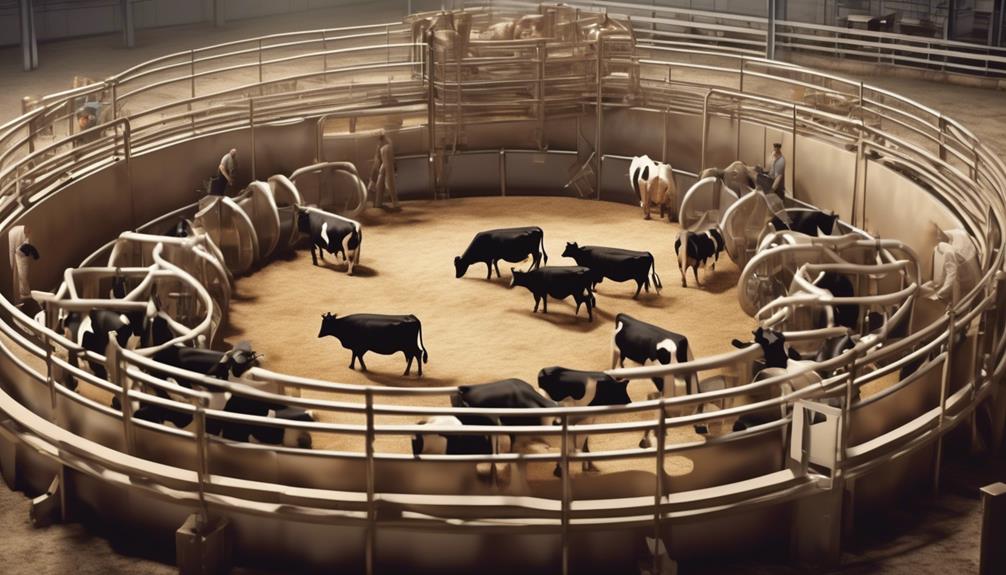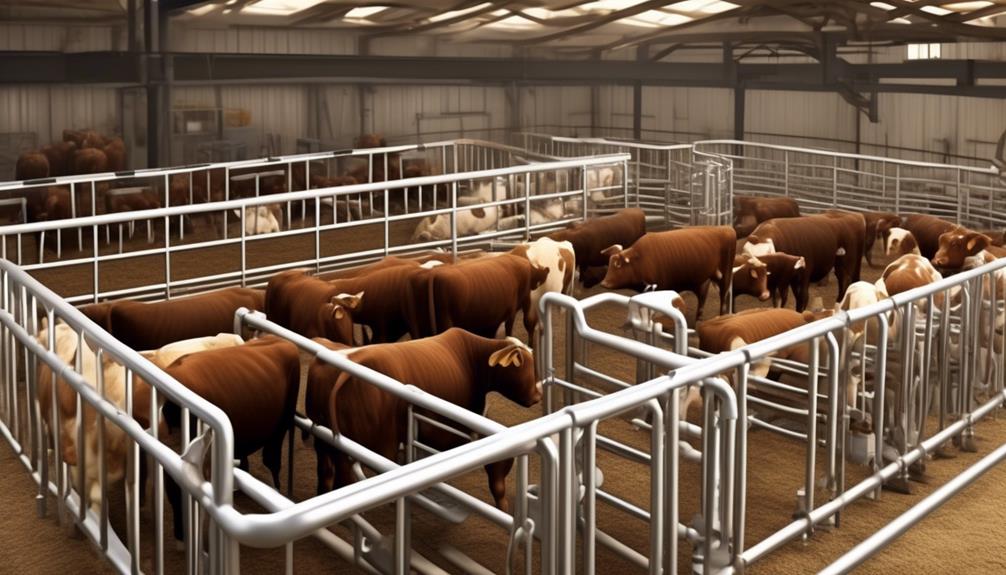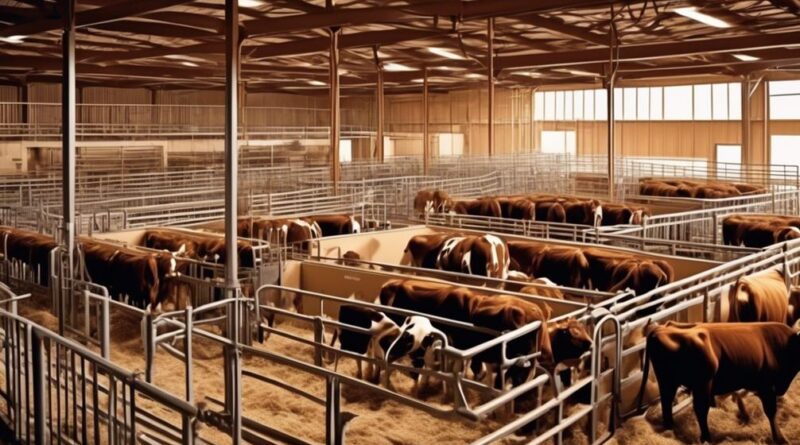Top Cattle Sorting Systems for Efficient Handling
When it comes to efficient cattle handling, finding the right sorting system is like discovering the perfect tool for a complex job – it can make all the difference.
But with so many options available, how do you know which one is best suited for your needs? Understanding the various cattle sorting systems and their unique features is essential for making an informed decision.
Whether you're focused on minimizing stress for the animals, streamlining operations, or maximizing productivity, the right sorting system can significantly impact your bottom line.
So, let's explore the top cattle sorting systems that are designed to enhance efficiency and precision in handling cattle.
Rotary Cattle Sorting System

You'll find the rotary cattle sorting system to be an efficient and reliable method for separating and directing cattle within a handling facility. This system offers several benefits, including increased efficiency in sorting and handling cattle. The rotary design allows for continuous cattle flow, reducing stress on the animals and improving overall handling. Additionally, it provides a safer working environment for the operators, as it minimizes direct contact with the cattle during sorting.
However, there are some drawbacks to consider. The initial setup cost for a rotary cattle sorting system can be significant, which may deter some operations from adopting this technology. Maintenance and repair of the system also require specialized knowledge and can add to the overall operational expenses. Moreover, the size of the system may pose challenges for smaller facilities with limited space.
Despite these drawbacks, the industry has seen a steady adoption of rotary cattle sorting systems. Larger cattle handling facilities have increasingly integrated this technology due to its proven effectiveness in streamlining operations. The ability to efficiently sort and direct cattle not only saves time but also contributes to better overall herd management. As more facilities experience the benefits of rotary cattle sorting, it's expected that the adoption of this system will continue to grow in the industry.
Hydraulic Cattle Chute System
The effectiveness of the rotary cattle sorting system has paved the way for advancements in cattle handling technology, such as the hydraulic cattle chute system. This innovative system offers enhanced efficiency and safety in managing cattle.
Here are some key points to consider:
- Hydraulic Chute Maintenance
- Regular maintenance of the hydraulic components is crucial for optimal functionality and safety. This includes checking for leaks, ensuring proper lubrication, and inspecting hydraulic hoses for wear and tear. By adhering to a strict maintenance schedule, you can prolong the lifespan of the chute system and minimize the risk of malfunctions during cattle handling.
- Cattle Handling Safety
- The hydraulic cattle chute system significantly improves the safety of cattle handlers. Its advanced design allows for smooth and controlled cattle movement, reducing the likelihood of injuries to both the animals and the handlers. Additionally, the hydraulic system provides precise control, enabling handlers to safely restrain cattle for various procedures such as vaccinations, hoof trimming, and pregnancy checks.
- Efficiency and Productivity
- With its hydraulic-powered features, this system streamlines the process of sorting, restraining, and treating cattle. The efficient operation not only saves time but also minimizes stress on the animals. This, in turn, can lead to improved productivity and better overall herd management.
RFID Cattle Sorting Technology

Utilizing RFID technology in cattle sorting enables precise identification and streamlined sorting processes, enhancing operational efficiency and herd management. Livestock management greatly benefits from the integration of RFID technology into sorting systems.
By using RFID ear tags, each animal can be uniquely identified, allowing for efficient sorting based on specific criteria such as age, weight, or health status. This technology eliminates the need for manual identification and sorting, reducing labor costs and minimizing errors.
RFID cattle sorting technology also provides real-time data on individual animals, enabling better decision-making in livestock management. With RFID readers installed at sorting gates, the system can automatically identify and divert cattle to designated areas without human intervention. This not only speeds up the sorting process but also reduces stress on the animals, leading to improved animal welfare.
In addition, RFID technology integration allows for seamless tracking of cattle movement within the sorting facility. This level of traceability is essential for monitoring the health and well-being of the herd, as well as for complying with regulatory requirements.
Furthermore, the data collected through RFID technology can be analyzed to gain insights into the performance and behavior of the cattle, ultimately contributing to more informed decision-making in livestock management.
Automated Cattle Sorting Gates
Automated cattle sorting gates provide efficient and streamlined processes for directing livestock to designated areas within the sorting facility. These gates utilize advanced technology to automate the sorting process, making it easier to direct cattle to specific areas based on predetermined criteria. Here's how automated cattle sorting gates achieve this:
- Automated Sorting Algorithms:
These gates are equipped with sophisticated automated sorting algorithms that can analyze various factors such as weight, size, or RFID tag information to make real-time decisions on where each animal should be directed. The use of these algorithms ensures that the sorting process is quick, accurate, and tailored to specific sorting criteria.
- Sensor Integration for Accuracy:
Automated cattle sorting gates are integrated with various sensors that can effectively track and gather data on the cattle as they pass through the gates. These sensors can measure weight, read RFID tags, or even assess the physical characteristics of the animals. This integration of sensors ensures that the sorting process is highly accurate, minimizing errors and ensuring that each animal is directed to the correct location based on the established criteria.
- Efficient Workflow:
Cattle Sorting Scale Systems

To efficiently weigh and direct cattle to designated areas within the sorting facility, cattle sorting scale systems offer a reliable and accurate solution. These systems are designed to seamlessly integrate into the cattle sorting process, providing real-time data management and livestock tracking capabilities. By utilizing advanced technology, cattle sorting scale systems not only accurately weigh the animals but also facilitate the sorting process based on weight, ensuring efficient and precise handling of the livestock.
Data management is a crucial aspect of cattle sorting scale systems. These systems are equipped with software that allows for the seamless collection, organization, and analysis of weight and sorting data. This data management functionality enables operators to gain valuable insights into the weight distribution of the cattle, facilitating informed decision-making in the sorting process. Additionally, the data gathered can be used for record-keeping and performance analysis, contributing to overall operational efficiency.
Livestock tracking is another key feature of cattle sorting scale systems. These systems are capable of identifying and tracking individual animals as they move through the sorting process. By leveraging this livestock tracking capability, operators can monitor the movement of cattle, accurately record weight data for each animal, and ensure that the animals are directed to their designated destinations within the sorting facility.
Remote-Controlled Cattle Sorting
Interested in enhancing your cattle sorting process? Consider implementing remote-controlled cattle sorting, a modern and efficient method for directing livestock within sorting facilities.
This cutting-edge technology allows you to remotely manage and direct the movement of cattle, providing a safer and more streamlined sorting process. Here's why remote-controlled cattle sorting is revolutionizing livestock management:
- Increased Efficiency: With remote-controlled systems, you can efficiently direct the flow of cattle, reducing the time and labor traditionally required for sorting. This technology enables you to remotely guide the movement of livestock, reducing the need for physical intervention and minimizing stress on the animals.
- Enhanced Safety: Remote-controlled cattle sorting systems offer a safer alternative to traditional sorting methods. By allowing you to manage the process from a distance, these systems minimize the risk of injury to both livestock and handlers. Additionally, remote monitoring enables you to oversee the sorting process without directly entering the sorting area, further enhancing safety protocols.
- Remote Monitoring: Implementing remote-controlled cattle sorting provides the ability to closely monitor livestock movement from a distance. This feature allows for real-time tracking of individual animals, ensuring precise sorting and reducing the likelihood of errors. Remote monitoring also facilitates better decision-making, as you can assess the sorting process and make adjustments as needed without physically intervening.
Incorporating remote-controlled cattle sorting into your livestock management practices can significantly improve efficiency, safety, and overall sorting process effectiveness.
High-Throughput Cattle Sorting

Considering the advancements in cattle sorting technology, high-throughput cattle sorting offers an innovative approach to efficiently managing large volumes of livestock within sorting facilities. Cattle behavior in sorting plays a crucial role in the success of high-throughput systems. Understanding how cattle move and react in response to various stimuli, such as visual cues and sound, enables the design of sorting systems that minimize stress and optimize throughput. High-throughput sorting systems are engineered to accommodate the natural movement patterns of cattle, facilitating efficient and gentle handling.
The economic impact of high throughput sorting is significant. By streamlining the process of sorting and handling large volumes of cattle, these systems can reduce labor costs and increase overall operational efficiency. With the ability to quickly and accurately sort cattle based on various parameters such as weight, size, and condition, high-throughput sorting systems allow for improved management and utilization of livestock resources. This not only benefits the operational efficiency of sorting facilities but also contributes to the overall profitability of cattle operations.
Versatile Cattle Sorting Alleys
With versatile cattle sorting alleys, you can effectively manage and direct livestock movement within sorting facilities. These alleys are designed to enhance the efficiency of cattle handling and sorting operations while prioritizing the safety of both the animals and the handlers.
Benefits of Versatile Cattle Sorting Alleys:
- Efficient Workflow: Versatile cattle sorting alleys are engineered to streamline the flow of cattle through the sorting process. They incorporate features such as adjustable alley widths, strategically placed gates, and smooth corners to minimize congestion and enable the swift and orderly movement of livestock. This optimization of workflow reduces the time required for sorting and enhances overall operational productivity.
- Improved Safety Measures: These alleys prioritize the safety of both cattle and handlers. The design elements, such as non-slip flooring, rounded corners, and sturdy construction, contribute to minimizing stress on the animals and reducing the risk of injuries. Additionally, the improved visibility and access points provided by these alleys enable handlers to effectively manage cattle movement while maintaining a safe distance.
- Adaptability: Versatile cattle sorting alleys are designed to accommodate various cattle sizes and temperaments. The adjustable features allow for customization based on the specific requirements of different livestock, ensuring that the sorting process can be tailored to the unique needs of the animals being handled.
Incorporating versatile cattle sorting alleys into your sorting facility can significantly enhance the efficiency and safety of cattle handling and sorting operations.
Frequently Asked Questions
What Are the Potential Maintenance Costs Associated With Each Type of Cattle Sorting System?
When considering maintenance costs for cattle sorting systems, it's important to assess system durability and energy efficiency. Regular upkeep can minimize potential expenses, while proper waste management contributes to long-term savings.
How Do Different Cattle Sorting Systems Handle Varying Sizes and Breeds of Cattle?
Different cattle sorting systems handle varying sizes and breeds of cattle differently, impacting handling efficiency. Understanding cattle behavior, breeding management, and genetic diversity is crucial. Consider these factors when choosing the right sorting system for your operation.
Are There Any Specific Training or Certification Requirements for Operating These Cattle Sorting Systems?
To operate cattle sorting systems, you need training and certification. These systems have specific operational requirements that require expertise. Training ensures you understand how to effectively handle and sort cattle using these systems.
Can These Systems Be Easily Integrated With Existing Cattle Handling Equipment and Infrastructure?
Yes, these systems can be easily integrated with your existing cattle handling equipment and infrastructure. However, it's essential to consider potential integration challenges and compatibility issues to ensure a seamless transition and efficient operation.
What Are the Potential Environmental Impacts of Using These Cattle Sorting Systems, Such as Energy Consumption or Waste Production?
When using cattle sorting systems, consider the potential environmental impacts. Ensure energy efficiency and proper waste management to minimize negative effects. Evaluate sustainability and environmental impact to make informed decisions for your operations.
Conclusion
So, when it comes to efficient cattle handling, these top cattle sorting systems offer a range of options to suit your needs.
From rotary systems to RFID technology, there are solutions to make the process smoother and more streamlined.
By incorporating these systems into your operation, you can improve efficiency, reduce stress on the animals, and ultimately increase productivity.
Choose the right system for your needs and watch your cattle handling process become more efficient than ever.
